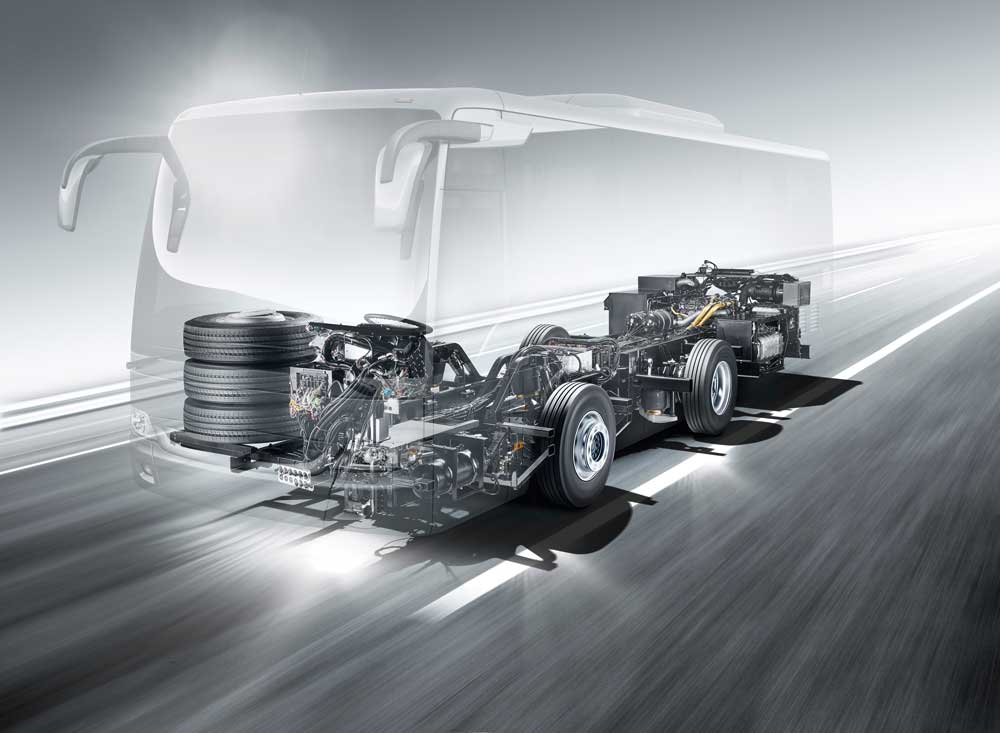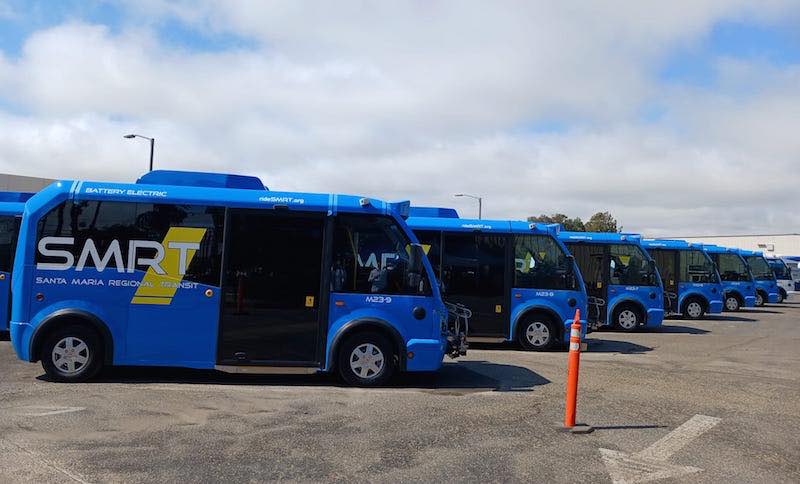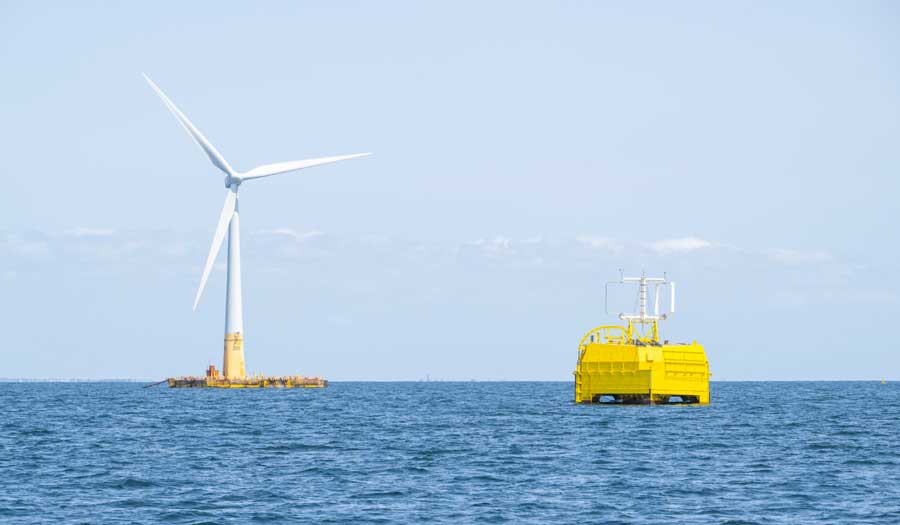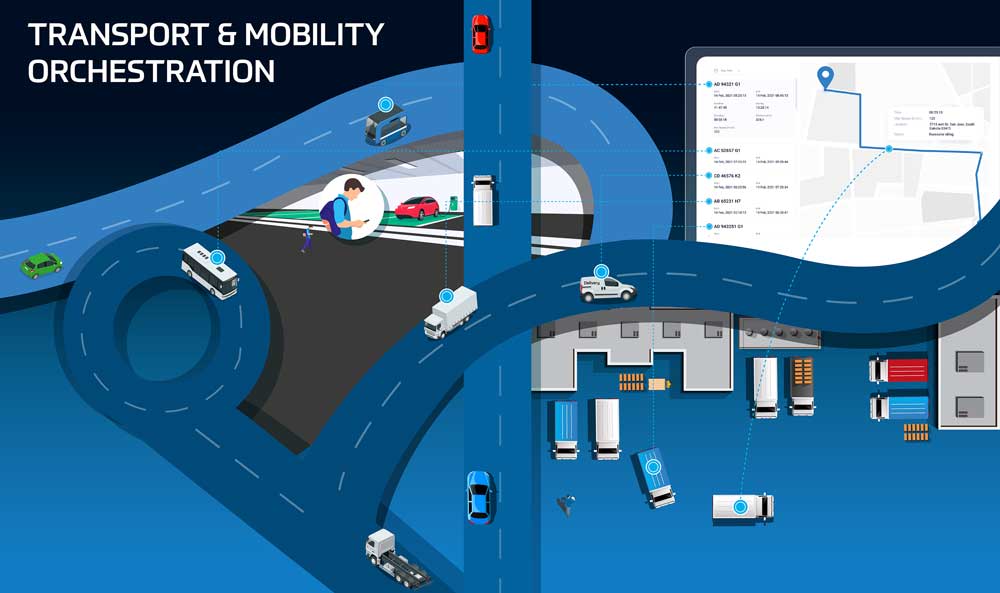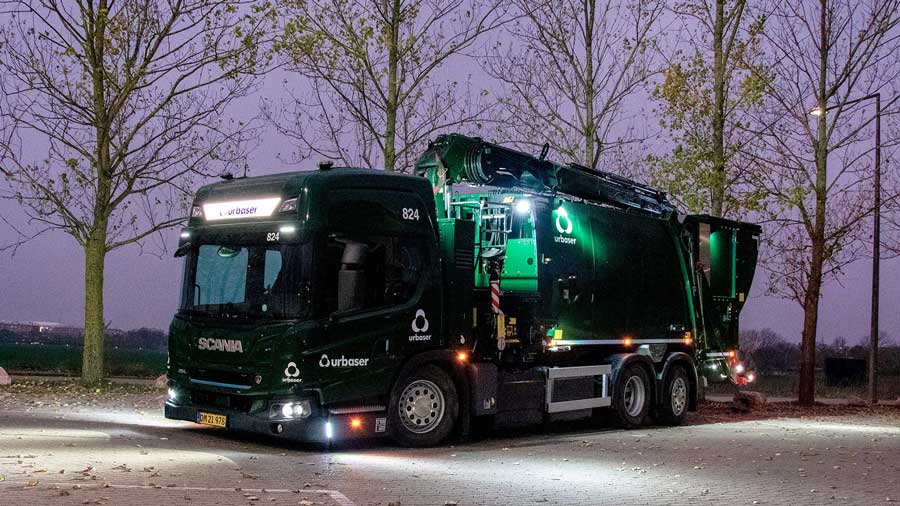In the majority of the world, buses consist of a chassis and a body from a specialized manufacturer. Daimler Buses is showcasing its technological excellence with the upgrade of the Mercedes-Benz OC 500 bus chassis for Euro VI engines. With the Active Brake Assist 5 emergency braking system and Sideguard Assist, unique assistance systems are being introduced. A wealth of individual measures significantly reduces fuel consumption. Drivers benefit from state-of-the-art operating systems. And even more features are available to bodybuilders. The new chassis generation is available in the OC 500 RF (Raised Floor) and OC 500 LE (Low Entry) variants The chassis will be celebrating their public launch at the FIAA trade fair from October 18 – 21 in Madrid.
High level of safety: Active Brake Assist 5 and Sideguard Assist
At the heart of the new generation of the Mercedes-Benz OC 500 chassis family is a new electrical/electronic structure. It forms the basis for, among other things, new assistance systems. With them, the chassis bearing the three-pointed star set the mold throughout the industry.
Presented by Mercedes-Benz in 2008, the fifth generation of Active Brake Assist, which has undergone continuous further development since then, is once again achieving a higher level of performance. ABA 5 uses a combination of radar and a camera system. Within the system limits, this assistance system can initiate maximum full-stop braking for stationary and moving obstacles as part of an automated process. As the world’s first emergency brake assistant for buses, ABA 5 is even able to initiate automated maximum full-stop braking in front of moving pedestrians.
An additional function of Active Brake Assist 5 is radar-based adaptive cruise control (ACC). It is optionally available on board the OC 500 RF chassis. It takes the strain off the driver on highways and freeways. If the assistance system detects a slower vehicle ahead, it automatically brakes the bus until a speed-dependent distance previously selected by the driver has been reached, which the system then maintains constant. With the additional Stop-and-GO function, Stop Assist, the speed range of the ACC is extended to a standstill if it is equipped with the fully automated Mercedes GO 250–8 PowerShift transmission. If the vehicle is only stationary for a short time, the bus moves off again automatically when the vehicle in front starts moving.
The outstanding new safety features of the OC 500 chassis also include the optional, Sideguard Assist cornering assist system with pedestrian detection. This especially supports the driver when turning off in urban areas, and effectively protects vulnerable road users such as pedestrians and cyclists. The centerpiece is formed by two short-range radar sensors on the front passenger’s side. If there is a moving object in the monitored zone, a triangular LED lights up yellow at the driver’s eye level on the front-passenger’s side. If the sensors detect a risk of collision, the LED light also flashes red several times at a higher luminosity before it turns permanently red after two seconds. A vibration warning is also triggered in the driver’s seat. Sideguard Assist also warns of stationary obstacles along the bend. Sideguard Assist is available for all OC 500.
Maximum efficiency: Noticeably lower fuel consumption
Using a whole host of measures, developers are also noticeably reducing the already favorable fuel consumption and with that the emissions even further.
The optional Predictive Powertrain Control (PPC) intelligent adaptive cruise control is of great importance here. It integrates a driving style adapted to the topography into the automatic transmission and, in conjunction with the precisely tuned transmission strategy, enables noticeable fuel savings. PPC predictively accelerates the vehicle, actively uses coasting phases using EcoRoll with neutral positioning of the gearbox and automatically adapts the gear selection to the topography and road events. In addition to the satellite-based positioning system, Predictive Powertrain Control also employs precise 3D maps.
With its expanded map material, the latest generation of PPC now covers almost all extra-urban roads in Europe in addition to highways and trunk roads. PPC operates on country roads, considers intersections and traffic circles, and is networked with adaptive cruise control.
PPC avoids unnecessary braking, accelerating or shifting on winding out-of-town journeys and thereby helps the driver achieve a low wear and low fuel consumption driving style. If required, all PPC interventions can be overridden by the driver at any time by brake application or pressing on the accelerator pedal. The driver remains responsible for the bus’s journey. The prerequisite for PPC with its full range of options is the fully automated Mercedes GO 250–8 PowerShift manual transmission.
Mere details can also reduce fuel consumption. The intelligent on-board electrical system control with battery sensor leads to charging of the batteries, preferably in overrun or braking mode. The TPMS (Tire Pressure Monitoring System) shows the current individual tire pressures and warns of deviations from the optimum pressure. This reduces tire wear, has a positive effect on fuel consumption, and prevents dangerous tire damage.
The generation change to the ZF Ecolife 2 automatic transmission with torque converter in the OC 500 LE chassis and the two-axle OC 500 RF also reduces fuel consumption.
All this and other measures lead to a significant reduction in fuel consumption and thereby also emissions. It becomes obvious on a chassis: Ultimately, the exact value also depends on the individual body and the use of the completely assembled bus.
Daimler Buses takes a holistic view of economic efficiency. For this reason, all chassis of the new generation are equipped with the “Bus Data Center” telematics box as standard. It serves as a transfer unit for a large amount of data. This opens up the entire world of Omniplus ON, the diverse digital services of the Omniplus service brand from Daimler Buses, now also for bus chassis. Omniplus ON networks the vehicle, driver, company and service with one another and develops added value for bus companies from this. Even free basic services create transparency with regard to important fleet data. OMNIplus Uptime is revolutionary: This service constantly monitors and checks the vehicle systems.
In addition to the technology, the focus is also on the driver. The new optional Driver Score assistance system evaluates the driver’s personal driving style using numerous parameters. The assistance system provides the driver with up-to-date feedback on their individual driving style. The driver can access the corresponding data while driving or afterwards in the display. In the event of significant deviations from an ideal driving style, the driver is provided with practical tips on how to optimize their driving.
Clear-cut operation: Clearly arranged instruments, electronic parking brake
Mercedes-Benz buses are traditionally highly geared towards drivers. This is also reflected in the extensively upgraded chassis. This starts right from firing up the engine, where an optionally available multifunction key replaces the conventional ignition key. The cockpit is equipped with a multifunction steering wheel. A rain/light sensor is also always installed. Another new feature is the clearly arranged instrument panel including the central display. Like the multifunction steering wheel, it originates from a well-known sister within the brand’s portfolio, the Mercedes-Benz Tourismo.
The standard electronic parking brake knob forms part of the dashboard . It combines simple handling and a high level of safety. The driver activates the parking brake manually by pulling the lever or by pressing the “P” button. They release the parking brake either by stepping on the accelerator pedal or by pressing the “P” button again. A hold function is integrated as an option. It is activated when the vehicle is stationary by stepping on the brake pedal more forcefully. The brake is not released until the driver presses the accelerator again. When moving off on hills, the system supports the driver with the standard integrated starting-off aid. Finally, the parking brake is automatically activated when the bus is stationary and the driver switches off the ignition. This prevents the bus from rolling away unintentionally.
Other functions: Bodies can use additional features
Compatibility with a wide range of bodies is particularly important for chassis. Mechanically, and in its major assemblies, the new chassis generation has remained largely unchanged. The additional interface between the chassis and the body on the basis of the CAN data bus is new. It allows additional functions and notifications. This includes, for example, a moving-off lock when the door is open, information about open flaps in the instrument panel or a warning regarding the open door of the driver’s cab door on a scheduled-service bus on the low-entry chassis.
Large selection: One chassis, many variants
With its variants, the new chassis generation covers almost all applications. Mercedes-Benz OC 500 RF: Two and three-axle chassis for high-floor buses with the Mercedes-Benz OM 936 and OM 470 engines, a power range from 220 kW (299 hp) to 335 kW (456 hp) and transmission variants from the Mercedes GO-190 manual transmission to the fully automated Mercedes GO 250–8 PowerShift transmission and the ZF Ecolife 2 automatic transmission with torque converter. OC 500 LE: Two‑axle chassis for low-entry buses, Mercedes-Benz OM 936 engine, performance 220 kW (299 hp) or 260 kW (354 hp), ZF Ecolife 2 converter automatic transmission.
All versions of the OC 500 are available as left-hand and right-hand drive vehicles, all engines comply with the current Euro VI E emissions standard.


